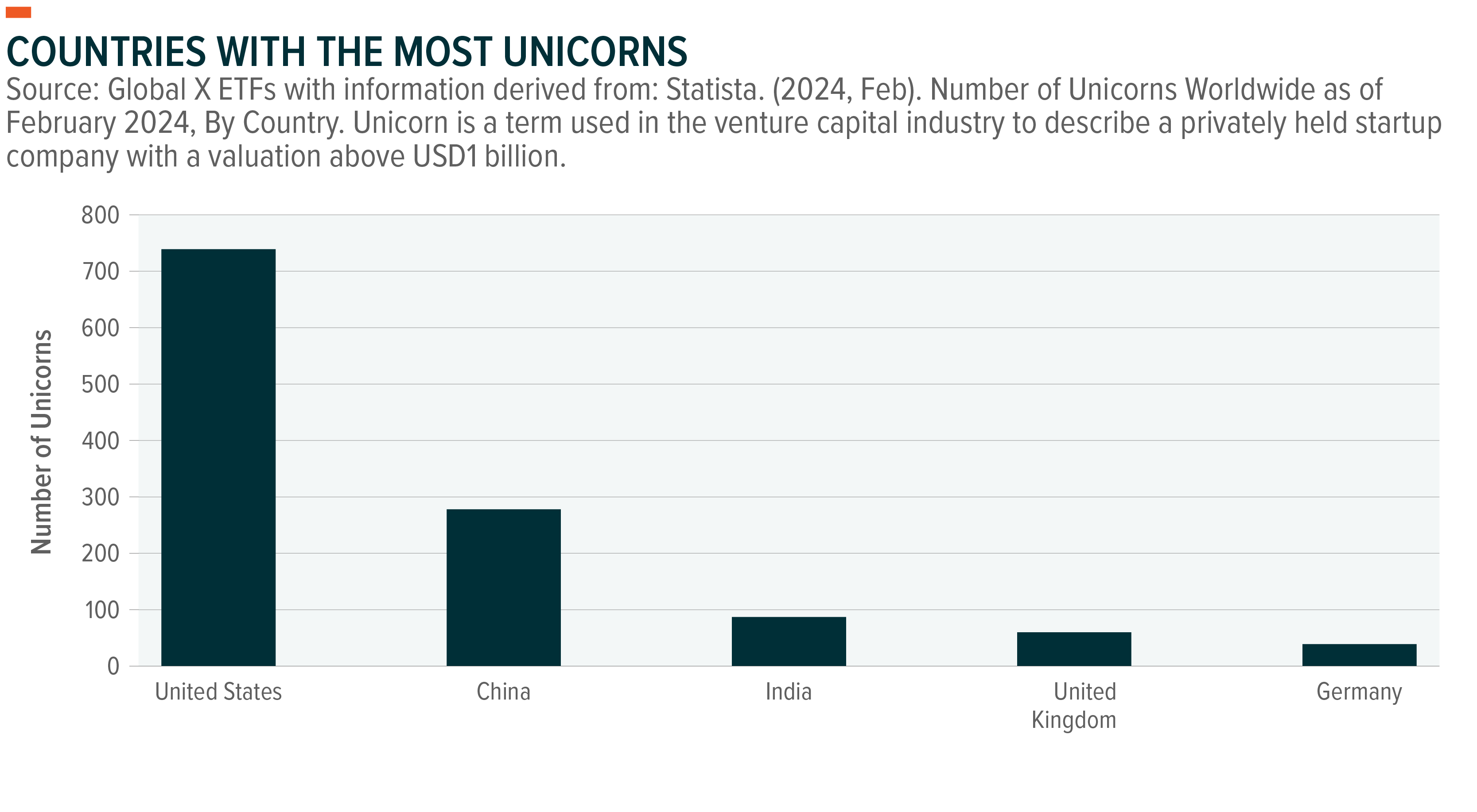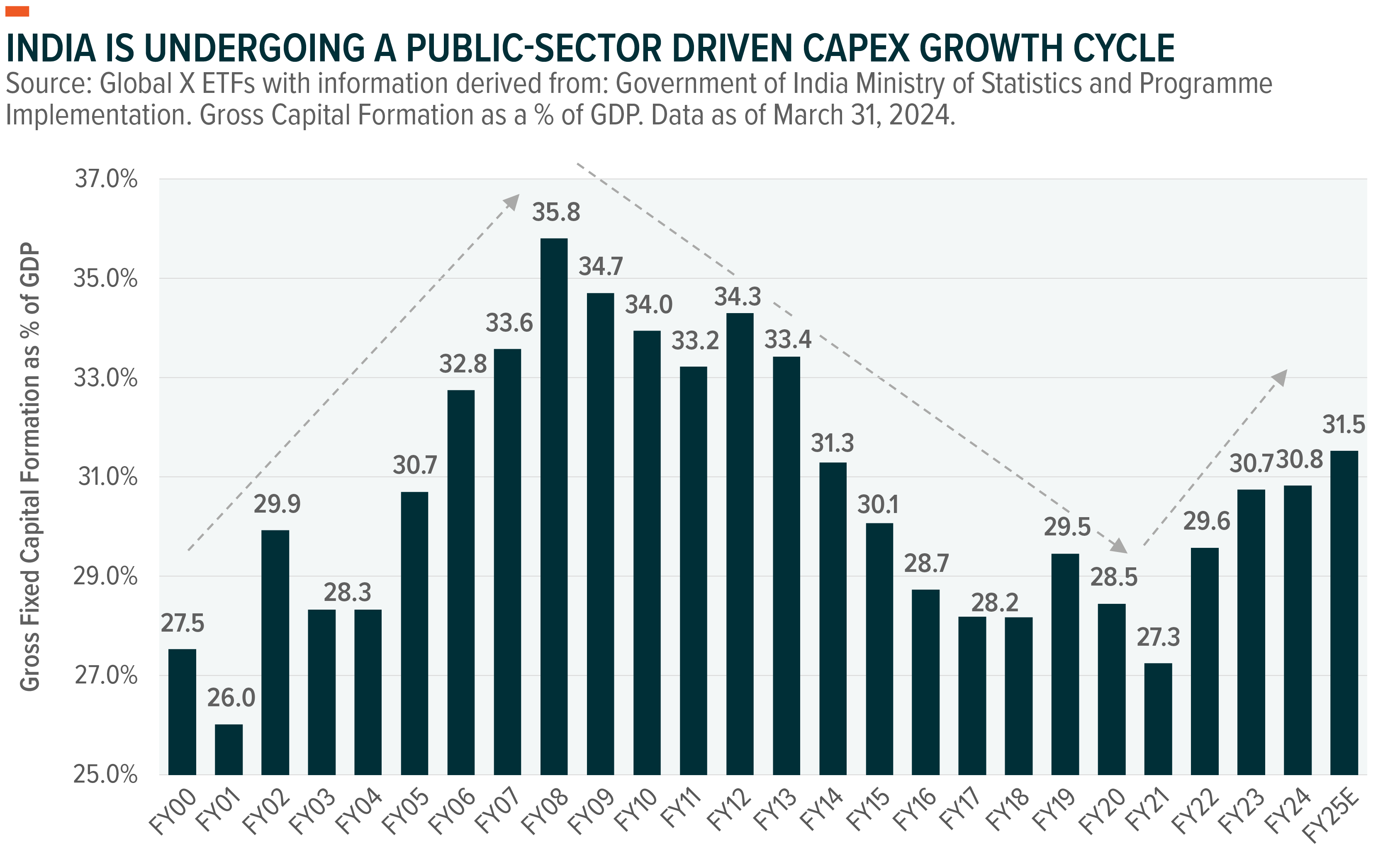Views From the Ground: India – Keep Calm and Carry on Compounding
We continue to see India as the best structural growth opportunity in international markets. Our recent due diligence trip to Mumbai consisted of over 25 meetings with management teams, local investors, sector specialists, and economists. We worked closely with our affiliate, Mirae Asset’s, 15-person Mumbai-based analyst team and walked away enthusiastic on India’s near- and long-term investment prospects. With over 15 years on the ground, Mirae Asset maintains a leadership position in the Indian asset management landscape. Most importantly, we left feeling that the Indian economy has a long runway for growth and that our holdings boast robust business models with conservative balance sheets and disciplined management teams.
Key Takeaways
- India is in the midst of a powerful, public-sector driven capital spending (capex) cycle at the same time the private sector has been deleveraging, with Indian market debt levels at roughly 15-year lows.1 This potent combination is a key long-term structural driver behind our positive view on India.
- India boasts a rare combination of favorable demographics, a strong educational backdrop, and a business-friendly government that has cut taxes and increased spending while at the same time driving fiscal consolidation, potentially setting the country up for long-term success.
- Indian management teams feel that India stands out as a potential beneficiary from the Republican sweep in the recent U.S. elections in that (1) Higher tariffs for China may create opportunities for India, (2) Potentially higher oil supply could reduce the cost of energy and improve India’s trade balances, and (3) Prime Minister Modi and President Trump have had previous strong ties that could expand over the next four years.
We Believe India is the Best Structural Story in International Markets
India has found itself in a sweet spot that could elevate markets for decades to come. The country boasts the largest population in the world, the largest youth population in the world, and a strong educational backdrop.2,3 This likely sets a powerful stage for innovation, growth, and spending. However, as career Emerging Market (EM) managers, we know that demographics alone can’t support a market; we have seen challenging governance get in the way too many times. That said, India presents a unique story. Prime Minister Modi has just been elected for a third term. During his first two terms, we saw 250mn people join the middle class and 77mn people move into the wealthy category.4,5 Modi has driven growth via market friendly policies (including cutting the corporate tax rate from 30% to 22%) and a commitment to productive spending across both physical and digital infrastructure.6 We know what you’re thinking: that’s nice, but spending plus tax cuts equals a fiscal disaster. Not in this case. Modi’s policies and partnerships have digitized the country, drawn the informal economy into the banking system, and raised revenues via efficiencies in tax collection. Long story short, he has implemented tax cuts, kept his foot on the gas in terms of spending, and driven fiscal consolidation at the same time. This is a unique model potentially setting India up for long-term success.
A Digital Edge
We previously wrote about India’s digitization journey, and our views from the ground confirmed our belief that the country’s digital backbone is setting the stage for rapid multi-year growth. In addition to country-wide 4G and 5G speed and affordable smartphones (we were able to test Jio’s new USD13 phone) and data (data in India costs 97% less than in the U.S.), we see three key pillars standing out.7
- Identification:The first pillar to support the digital revolution is based on initiatives like Aadhaar, a unique digital identity program that helps over 95% of Indians access essential services and fosters financial inclusion.8
- Payments:The second pillar is based on the government run Universal Payment Infrastructure (UPI). UPI helps formalize the economy by creating a need for digital transactions, which drives up bank accounts and deepens financial inclusion, as it helps small and unbanked businesses/individuals establish credit. If you’re paying digitally, you have a bank account, and if you have a bank account, you’re more likely to be paying taxes.
- Access:India has expanded high speed internet networks across the country to help citizens take up the use of digital services. Smartphone penetration has grown from around 250mn in 2015 to over 1bn in 2023 with close to a 71% penetration rate.9 While in Mumbai, we witnessed the release of Jio’s new USD13 smart phone, which should continue to drive connectivity.
When you combine the facts that (1) India is young, (2) The Indian education system is focused on sciences, technology, engineering, and math, and (3) India boasts robust digital infrastructure – it’s easy to see a backdrop for entrepreneurship, innovation, and growth.

Plus a Roaring Old Economy!
Capex cycles in India have historically lasted roughly eight years. We have seen gross fixed capital formation (GFCF) as a percentage of gross domestic product (GDP) decline from a peak near 36% in 2008 to a low of 27% after the COVID-19 pandemic in 2021.10 Since then, India has experienced a powerful, public-sector driven capex cycle with the central government promising to spend around Rs12.7tn this year and another Rs15tn, or 18% more, next year.11 This is the government’s largest outlay for capex ever and represents ~3.4% of GDP.12 Importantly, this massive investment program is coinciding with the ending stages of a deleveraging process from the private sector that started just after PM Modi’s pro-business and fiscally conservative BJP party came to power in 2014. Corporate debt-to-equity (D/E) ratios declined from a peak of ~1x in 2015 to ~0.5x today, levels last seen over 15 years ago.13 Fundamentally, this implies a significant capacity to lever up, spend, and invest in the economy over the next decade. This powerful combination is a key long-term structural driver behind the positive India story. While cyclical sectors will likely benefit in the shorter term, we left the country more optimistic on certain sectors such as power (e.g. utilities, renewables, and generation) due to the growing supply/demand imbalance in the country coupled with several government initiatives, such as plans to grow renewable capacity to 500GW by 2030.14


Another secular theme playing out in India has been the positive benefit of friendshoring trends and the implementation of policies that support foreign direct investment (FDI). Companies started to look at diversifying supply chains out of China around 2016 to reduce political risks, but the process accelerated after the COVID-19 pandemic. India has been a natural beneficiary of China+1 policies, as the government has actively taken steps to support FDI. These include cutting corporate taxes to attract manufacturing investment, lifting public capex as a percentage of GDP to 10-year highs, and the introduction of a World Trade Organization (WTO) compliant production linked incentive (PLI) scheme to bridge cost inefficiencies.15 We anticipate these trends to remain firmly in place, with economists forecasting India’s global export market share to more than double to 4.5% by 2030 from 1.9% in FY22 as its manufacturing share in GDP climbs from ~16% in 2022 towards 21% by 2030.16 Few companies represent this ongoing shift better than Apple. The company started assembling iPhones in India in 2017 and has doubled production there to US$14bn, with one in seven iPhones sold globally now made in India, with an aim of one in four within the next four years.17 Amazingly, despite holding roughly 6% of the domestic smartphone market, Apple only opened its first retail store in the country in 2023.18
Long Runway for Growth
- India has a 610mn person Gen Z population versus 424mn in China and 104mn in the U.S.19
- Only 7% of Indians have air conditioning compared to 60% in China and 90% in the U.S.24
- Despite high connectivity and a larger and younger population than China, India’s e-commerce market stands at only roughly USD60bn versus USD1.5tn in China.20
- India’s mortgage market stands at only 36% of GDP versus 61% in China, 67% in Malaysia, and 87% in Thailand.21
- We believe that urbanization acted as a significant tailwind for China’s growth in the early 2000s. China’s urbanization rate stands at 66% versus only 36% in India, representing a potentially similar pattern.23
- In 2023, 394mn people in India were considered low income or low-middle income. By 2030, 884mn people in India are projected to be in high income or high-middle income brackets.22
Quick Bullets From the Ground
- Young People Want to be in India:India’s average age is 28 years old (versus 39 in China).25 We met young workers across the board. Some came from rural areas and some were educated in the West and came back to take advantage of growth in India. All were energized and hungry to be a part of this dynamic growth story.
- Consumer Sentiment is Strong:Feedback from management teams we met with on this year’s Diwali season versus 2023 was positive. This was especially true across jewelry, apparel, and premium products.
- Digital Banking Adoption Continues to Rise:Real time digital transactions (UPI) in India have improved from only 2.9mn transactions in 2016 to more than 11mn every 30 minutes.26
- All Eyes on the 2025 Federal Budget:Delays in capex disbursement imply the government would need to increase capex by more than 50% in the second half of the year to reach its target for this fiscal year. Although we expect an acceleration in capex deployments in the remainder of the year, the FY2025 federal budget will likely continue with the BJP’s steady mantra of increasing investment balanced with fiscal consolidation, something the market should continue to appreciate and could be a key catalyst in 1Q25.
- Domestic Flows Remain Supportive:Domestic demand remains healthy as an increasing amount of financial savings are put in equities towards OECD standards of ~20%. Domestic institutional investors are adding roughly $2.5-3bn of systematic investment plan investments with another $1.5bn from pension funds and employee contributions driving over $50bn in annual flows into equities.27
Meeting Highlights
- Shiram Finance:A non-bank lender financing individuals and SMEs (small- and medium-sized enterprises) across personal vehicles, commercial vehicles, business, and personal loans. Roughly 90% of loans are against sustainable earning assets with approximately 95% of loans collateralized. Advantages come in the form of scale, hiring practices (they hire between ages 21-25 and only train and promote from within), digitalization (over 10mn people are on their app), efficiency (cost to income is one of the lowest levels in global finance), and alignment (variable pay for everyone from entry employees to the CEO).
- Reliance:India’s largest conglomerate that is moving away from just energy to a retail and digital business. Build it and they will come – the company has invested in a massive digital backbone to support longer-term monetization of mobile and digital data consumers. They target doubling revenue and EBITDA in these two structural growth segments over the next 3-4 years. An IPO for Jio and potential listing of retail business in the coming years will be some of the most closely followed market activity for foreign institutional investors and domestic investors alike.
Conclusion
In addition to these positive macroeconomic and structural trends, we were especially encouraged to see extremely low levels of debt on company balance sheets, management teams preaching capital discipline, and companies focused on expanding spreads between their returns on invested capital and their own costs of capital.
Big picture: GDP = Government Spending + Private Consumption + Private Investment + Net Exports
India is checking every single box and could grow GDP at a compound annual growth rate above 7% over the next five years. Combine this macroeconomic opportunity with sound management and attractive bottom-up fundamentals, and India could continue to grow as a percentage of most U.S. allocations.
Related ETFs
188A – Global X India Top 10+ ETF
Click the fund name above to view current performance and holdings. Holdings are subject to change. Current and future holdings are subject to risk.
